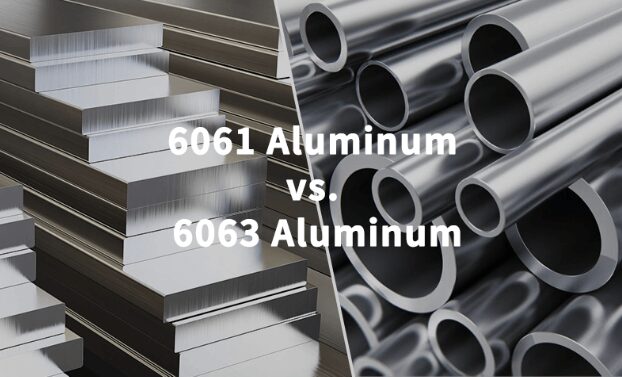When designing an aluminum extrusion, selecting the appropriate alloy (and its heat treatment temper) is crucial. The alloy determines key properties like strength, corrosion resistance, and extrudability. For most extruded profiles, the choice often comes down to two popular 6000-series alloys: 6063 and 6061. Both are magnesium-silicon alloys (they share over 99% of the same elements in composition) and offer good strength, corrosion resistance, weldability, and extrudability. However, there are important differences that make each one better suited for certain applications. Let’s compare 6063 vs 6061 and discuss how temper designations like T5 or T6 come into play.
6063 – The Architectural Alloy
Aluminum Alloy 6063 is sometimes called the “architectural aluminum” because it’s commonly used for window frames, door frames, and other decorative or extruded trim. It has slightly lower strength than 6061 but excellent extrudability and surface finish quality. 6063 can be extruded into complex, thin-walled shapes with fine detail, more easily than 6061. This makes it ideal for intricate profiles or where a smooth, high-quality surface is desired (such as parts that will be anodized for appearance). 6063’s typical tensile strength is in the range of 150–180 MPa (for T5/T6 tempers), which is lower than 6061’s potential, but still plenty for many light structural needs. It also has a slight advantage in corrosion resistance and anodizing response – partly because 6063’s chemistry is tuned for a more uniform finish without the trace copper content found in 6061. In practice, 6063 is the first choice for applications like curtain wall frames, picture frames, furniture, and LED lighting extrusions, where formability and finish are more important than maximizing strength.
From a manufacturing standpoint, 6063 flows through the die at lower pressure, allowing faster extrusion speeds and lower chance of cracking on intricate shapes. It’s often used in a T5 temper (cooled from extrusion and artificially aged) which provides a good balance of strength and ductility without additional solution heat treatment. Overall, if your design has very fine details, thin sections, or will be highly visible, 6063-T5 is likely the go-to alloy.
6061 – The Structural Alloy
Alloy 6061 is known for its higher strength and is often selected for more demanding structural applications. While it contains the same primary alloying elements as 6063 (Mg and Si), 6061 typically has additional elements like a bit of copper, giving it greater strength potential. 6061-T6 is significantly stronger than 6063, with tensile strength up to around 290 MPa. This additional strength makes 6061 suitable for load-bearing components such as machinery parts, automotive frames, structural framing, braces, and supports. If your extrusion needs to withstand higher stresses or serve as a mechanical part (like an bracket or a rail), 6061 is a prime candidate.
There are some trade-offs: 6061 is slightly less extrudable than 6063. Complex or very thin-walled profiles might be more challenging (or slower) to extrude in 6061, so design adjustments could be needed for extremely intricate shapes. Also, 6061’s surface finish after extrusion is usually not as smooth as 6063’s; it may show more surface grain or need extra finishing work if aesthetics are critical. Nonetheless, it still anodizes well and has good corrosion resistance (just marginally less than 6063 in certain environments). 6061 is commonly supplied in the T6 temper, meaning it’s solution heat-treated and artificially aged to reach maximum strength. This involves an extra heat treatment step after extrusion (as opposed to 6063 T5 which skips the solution treatment). The result is a harder, stronger material ready for use in structural roles.
Other Alloys and Tempers to Consider
6061 and 6063 cover the vast majority of extrusion needs, but a few other alloys see use. For example, 6005A or 6082 can provide higher strength for structural sections (at the expense of extrudability), and certain 7000-series alloys are occasionally extruded for ultra-high strength requirements despite the greater difficulty and cost.
When selecting an alloy-temper combination, consider the requirements of your project: – Strength: Determine the mechanical loads your profile must handle. If 6063-T5’s strength meets the need, that alloy’s other benefits might win out. If not, 6061-T6 or a stronger alloy may be necessary. – Profile Complexity: For very complex cross-sections or ultra-thin features, 6063 will be easier to push through the die. Using 6061 might force design compromises or slower production. – Surface Finish and Anodizing: If the extruded part will be visible or decoratively anodized, 6063 usually yields a more uniform, attractive finish. 6061 aluminum can be anodized too (often a slightly duller appearance), but 6063 is preferred for showcase pieces. – Weldability and Machining: Both alloys are quite weldable and machinable. 6061’s higher strength can make it a bit less formable than 6063, but it machines nicely, especially in T6 temper. If a lot of machining is required, either can work, though 6061-T6 will yield crisper machined edges.
In summary, choose 6063 for: maximum extrudability, intricate or thin-wall designs, and applications where appearance or finish is paramount. Choose 6061 for: higher structural loads, thicker or simpler shapes that prioritize strength, and as a general-purpose high-strength alloy. Always ensure to specify the temper (T5, T6, etc.), as that affects the properties greatly. Consulting with your extrusion supplier can also help – they can recommend an alloy based on their experience with similar projects. With the right alloy and temper, your aluminum extrusion will have the optimal balance of manufacturability and performance for your needs.































